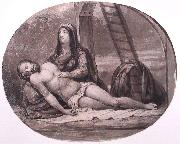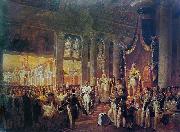Santo angelo Oil Painting ReproductionAll Santo angelo Oil Paintings(November 29, 1806 e December 30, 1879) was a Brazilian Romantic writer and painter, as well as an architect, diplomat and professor. He is patron of the 32nd chair of the Brazilian Academy of Letters. Porto-alegre was born Manuel Jose de Araejo in Rio Pardo, to Francisco Jose de Araejo and Francisca Antônia Viana. He would change his name to Manuel de Araejo Pitangueira during the independence of Brazil, due to nativist causes. Later on, he finally changed it to its definitive form: Manuel de Araejo Porto-alegre. In 1826, he moved to Rio de Janeiro, in order to study painting with Jean-Baptiste Debret at the Escola Nacional de Belas Artes. He also studied at what is now the Academia Militar das Agulhas Negras and took a Medicine course and Philosophy. In 1831, he left Brazil along with Debret to Europe, in order to improve his painting techniques. In 1835, he went to Italy, where he met Gonçalves de Magalhães, another Brazilian poet. He and Magalhães would create in France, in the year of 1837, a short-lived magazine named Niterei, alongside Francisco de Sales Torres Homem. Also in 1837, he becomes history painting teacher at the Escola Nacional de Belas Artes, in a post that would last until 1848, when he would become a drawing teacher at the Academia Militar das Agulhas Negras, and starts doing his first caricatures. In 1838, he married Ana Paulina Delamare, having with her two children: Carlota Porto-alegre (the future wife of painter Pedro Americo) and future diplomat Paulo Porto-alegre. In 1840 he is named the official painter and decorator of Emperor Pedro II's palace. He decorated the imperial palace in Petrepolis, the wedding of Pedro II with Teresa Cristina of the Two Sicilies and the aforementioned emperor's coronation. He was decorated with the Order of Christ and the Order of the Rose. Reuniting with Gonçalves de Magalhães and Torres Homem, he founded a periodic named Minerva Brasiliense, that lasted from 1843 to 1845. He would publish in this periodic his poem Brasiliana. In 1844, alongside Torres Homem, he founded the humoristic magazine Lanterna Megica, where he published his caricatures. In 1849, Porto-alegre founded the magazine Guanabara, alongside Joaquim Manuel de Macedo and Gonçalves Dias. The magazine, considered the official journal of the Romantic movement in Brazil, lasted until 1856. |
|||

|
|||
|
|
|||
|
||||||||
| Santo angelo (November 29, 1806 e December 30, 1879) was a Brazilian Romantic writer and painter, as well as an architect, diplomat and professor. He is patron of the 32nd chair of the Brazilian Academy of Letters. Porto-alegre was born Manuel Jose de Araejo in Rio Pardo, to Francisco Jose de Araejo and Francisca Antônia Viana. He would change his name to Manuel de Araejo Pitangueira during the independence of Brazil, due to nativist causes. Later on, he finally changed it to its definitive form: Manuel de Araejo Porto-alegre. In 1826, he moved to Rio de Janeiro, in order to study painting with Jean-Baptiste Debret at the Escola Nacional de Belas Artes. He also studied at what is now the Academia Militar das Agulhas Negras and took a Medicine course and Philosophy. In 1831, he left Brazil along with Debret to Europe, in order to improve his painting techniques. In 1835, he went to Italy, where he met Gonçalves de Magalhães, another Brazilian poet. He and Magalhães would create in France, in the year of 1837, a short-lived magazine named Niterei, alongside Francisco de Sales Torres Homem. Also in 1837, he becomes history painting teacher at the Escola Nacional de Belas Artes, in a post that would last until 1848, when he would become a drawing teacher at the Academia Militar das Agulhas Negras, and starts doing his first caricatures. In 1838, he married Ana Paulina Delamare, having with her two children: Carlota Porto-alegre (the future wife of painter Pedro Americo) and future diplomat Paulo Porto-alegre. In 1840 he is named the official painter and decorator of Emperor Pedro II's palace. He decorated the imperial palace in Petrepolis, the wedding of Pedro II with Teresa Cristina of the Two Sicilies and the aforementioned emperor's coronation. He was decorated with the Order of Christ and the Order of the Rose. Reuniting with Gonçalves de Magalhães and Torres Homem, he founded a periodic named Minerva Brasiliense, that lasted from 1843 to 1845. He would publish in this periodic his poem Brasiliana. In 1844, alongside Torres Homem, he founded the humoristic magazine Lanterna Megica, where he published his caricatures. In 1849, Porto-alegre founded the magazine Guanabara, alongside Joaquim Manuel de Macedo and Gonçalves Dias. The magazine, considered the official journal of the Romantic movement in Brazil, lasted until 1856. |
||||||||
|
|
||||||||
| Gemälde IDENTIFIZIERUNG:: 94283 D. Pedro I 1826(1826) Medium oil on canvas Dimensions 112 x 94 cm (44.1 x 37 in) cjr |
||||||||
|
|
||||||||
| Gemälde IDENTIFIZIERUNG:: 94284 Brazilian Jungle, cjr |
||||||||
|
|
||||||||
| Gemälde IDENTIFIZIERUNG:: 94285 Decorative panel 1851(1851) Medium Watercolor and China ink on paper. Dimensions 26.5 x 23.5 cm (10.4 x 9.3 in) cjr |
||||||||
|
|
||||||||
| Gemälde IDENTIFIZIERUNG:: 94286 Pieta cjr |
||||||||
|
|
||||||||
| Gemälde IDENTIFIZIERUNG:: 94287 Study for Pedro II's Sagration circa 1840(1840) Medium oil on canvas Dimensions 80 x 100 cm (31.5 x 39.4 in) cjr |
||||||||
|
|
||||||||
| VORHERIGER KÜNSTLER NÄCHSTER KÜNSTLER | ||||||||
|
|
||||||||
|
Santo angelo (November 29, 1806 e December 30, 1879) was a Brazilian Romantic writer and painter, as well as an architect, diplomat and professor. He is patron of the 32nd chair of the Brazilian Academy of Letters. Porto-alegre was born Manuel Jose de Araejo in Rio Pardo, to Francisco Jose de Araejo and Francisca Antônia Viana. He would change his name to Manuel de Araejo Pitangueira during the independence of Brazil, due to nativist causes. Later on, he finally changed it to its definitive form: Manuel de Araejo Porto-alegre. In 1826, he moved to Rio de Janeiro, in order to study painting with Jean-Baptiste Debret at the Escola Nacional de Belas Artes. He also studied at what is now the Academia Militar das Agulhas Negras and took a Medicine course and Philosophy. In 1831, he left Brazil along with Debret to Europe, in order to improve his painting techniques. In 1835, he went to Italy, where he met Gonçalves de Magalhães, another Brazilian poet. He and Magalhães would create in France, in the year of 1837, a short-lived magazine named Niterei, alongside Francisco de Sales Torres Homem. Also in 1837, he becomes history painting teacher at the Escola Nacional de Belas Artes, in a post that would last until 1848, when he would become a drawing teacher at the Academia Militar das Agulhas Negras, and starts doing his first caricatures. In 1838, he married Ana Paulina Delamare, having with her two children: Carlota Porto-alegre (the future wife of painter Pedro Americo) and future diplomat Paulo Porto-alegre. In 1840 he is named the official painter and decorator of Emperor Pedro II's palace. He decorated the imperial palace in Petrepolis, the wedding of Pedro II with Teresa Cristina of the Two Sicilies and the aforementioned emperor's coronation. He was decorated with the Order of Christ and the Order of the Rose. Reuniting with Gonçalves de Magalhães and Torres Homem, he founded a periodic named Minerva Brasiliense, that lasted from 1843 to 1845. He would publish in this periodic his poem Brasiliana. In 1844, alongside Torres Homem, he founded the humoristic magazine Lanterna Megica, where he published his caricatures. In 1849, Porto-alegre founded the magazine Guanabara, alongside Joaquim Manuel de Macedo and Gonçalves Dias. The magazine, considered the official journal of the Romantic movement in Brazil, lasted until 1856. |
||||||||
|
|
||||||||
|
KONTAKTIEREN Sie UNS |










